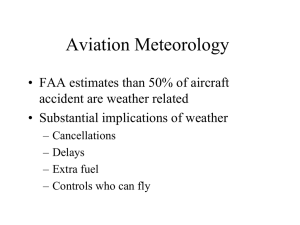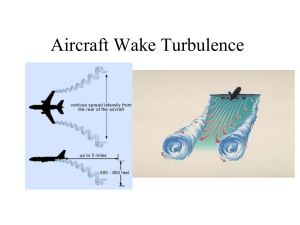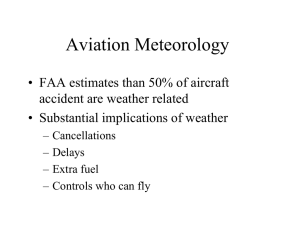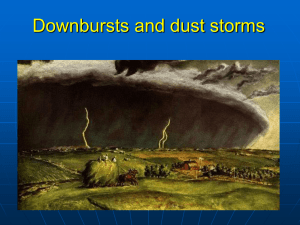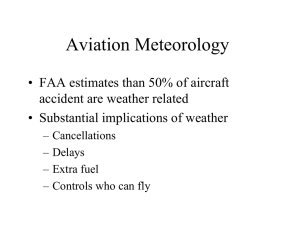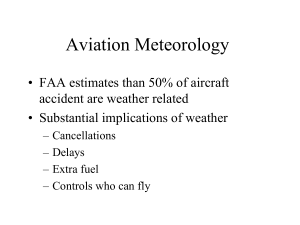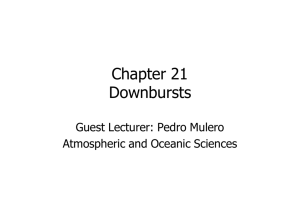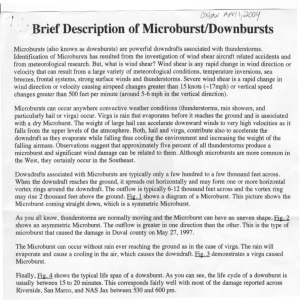Aviation452
advertisement
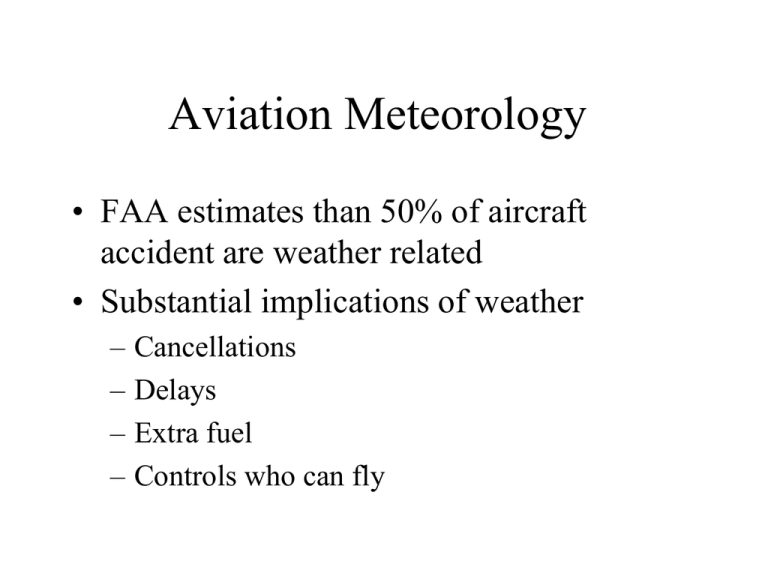
Aviation Meteorology • FAA estimates than 50% of aircraft accident are weather related • Substantial implications of weather – – – – Cancellations Delays Extra fuel Controls who can fly Major Aviation Hazards • • • • Icing Turbulence Obstructions to Visibility Wind shear Aircraft Icing Two main failure modes: 1. Commercial plane taking off 2. General aviation plane in terrain Air Florida Flight 90 13 January 1982 78 killed https://www.youtube.com/watch?v=S3uS_8OyoEI Icing Causes Problems in Many Ways • • • • • • Increased weight Decreased lift by changing shape of airfoil Increased drag Engine system icing Reduced control of aircraft surfaces Sensor malfunction. Rime Ice Clear Ice NOAA P3 During IMPROVE Physical Factors Affecting Aircraft Icing • Most icing occurs as aircraft fly through supercooled clouds or freezing rain. • Ice crystals (e.g., snow) are not problems— just bounce off aircraft. • Major factors include temperature, liquid water content, and droplet size distribution Temperature • T < -40C: no supercooled water and no threat • T > 0C, no problem • T between 0C and roughly -15C is the big threat range. • Few active freezing nuclei in this temperature range • Thus, lots of supercooled water, which freeze on contact with airframe. Liquid Water Content (LWC) • Probably the most important factor in determining ice accumulation rate. • In general, MUCH greater in cumuloform than stratiform clouds. • Generally highest at higher portion of clouds. Droplet Size Distribution • Small particles are collected less effectively. • Why? They tend to follow the airstream that is deviated by the aircraft. Large droplets have so much momentum that have a great tendency to hit the plane. Non-Meteorological Factors • Collection efficiency of aircraft • Aerodynamics heating Aircraft Wake Turbulence Boeing Field Low-Level Wind Shear Downbursts Downbursts can be Divided into Two Main Types • MACROBURST: A large downburst with its outburst winds extending greater than 2.5 miles horizontal dimension. Damaging winds, lasting 5 to 30 minutes, could be as high as 134 mph. • MICROBURST: A small downburst with its outburst, damaging winds extending 2.5 miles or less. In spite of its small horizontal scale, an intense microburst could induce damaging winds as high as 168 mph. Downbursts Microburst Dry Microburst • Damaging winds less than 2.5 miles in diameter • Accompanied by little or no rainfall Wet Microburst • Damaging winds less than 2.5 miles in diameter • Accompanied by very heavy rainfall and perhaps hail Downburst Video • http://www.youtube.com/watch?v=TkavH9 aZue8 • http://www.youtube.com/watch?v=S6ddot9j qOYhttp://www.youtube.com/watch?v=K8i lNyf5p-M Extremely Dangerous For Aircraft Landing and Taking Off Research by NCAR and collaborators in the 1980s uncovered the deadly one-two punch of microbursts: aircraft level off when they encounter headwinds, then find themselves pushed to the ground by intense downdrafts and tailwinds. The following are some fatal crashes that have been attributed to windshear/ microbursts in the vicinity of airports: • • • • Eastern Airlines Flight 66 Pan Am Flight 759 Delta Airlines Flight 191 USAir Flight 1016 Eastern Air Lines 66 June 24, 1975 New York – Kennedy Airport 112 killed 12 injured Crashed while landing Boeing 727 Pan Am 759 July 9, 1982 New Orleans Airport 145 passenger/crew killed 8 on ground killed Crashed after takeoff Boeing 727 Delta 191 August 2, 1985 Dallas-Fort Worth Airport Crashed on landing 8 of 11 crew members and 128 of the 152 passengers killed, 1 person on ground killed Lockheed L-1011 USAir 1016 July 2, 1994 Charlotte/Douglas Airport Crashed on landing 37 killed 25 injured McDonnell Douglas DC-9 August 1, 1983 the strongest microburst recorded at an airport was observed at Andrews Air Force Base in Washington DC. The wind speeds may have exceeded 150 mph in this microburst. The peak gust was recorded at 211 PM – 7 minutes after Air Force One, with the President on board, landed on the same runway. During take-offs the pilot experiences a headwind and increased aircraft performance followed by a short period of decreased headwind a downdraft and finally a strong tailwind During landings the airplane begins the descent flying into a strong headwind a downdraft and finally a strong tailwind represents the extreme situation just prior to impact Macroburst Wisconsin on the 4th of July, 1977, with winds that were estimated to exceed 115 mph, and completely flattening thousands of acres of forest Microburst Joint Airport Weather Studies (JAWS) • Major research effort between FAA and NCAR during the 1980s to understand and find ways of dealing with downbursts. • Centered at Stapelton Airport in Denver • Once the phenomenon was understood, proposed solution to allow warnings: terminal doppler radars and LLWAS. The Terminal Doppler Weather Radar (TDWR) is now deployed at 44 major airports. The TDWR mission is to provide wind shear detection services to air traffic controllers and supervisors Low Level Windshear Alert System (LLWAS) LLWAS • In 1983, the FAA asked NCAR to develop a version of LLWAS that could detect microbursts. • Between 1983 and 1988, NCAR developed and tested a new LLWAS system that detected microbursts, determined the strength in terms of headwind/tailwind gains or and located the event (on the runway, at 1, 2, or 3 nm on departure or arrival). • This system was later improved and is now called the Phase-3 LLWAS. A typical Phase-3 LLWAS will have enough sensors to be spaced 2-km apart (~1 nm apart) and cover out to 2 nm from the end of each major runway. The largest LLWAS is at Denver International Airport. It has 32 wind sensors. Most Phase-3 systems have between 12 and 16 wind sensors. Microburst “Season & Time” • The four best known downburst aviation disasters in the U.S. happened in the summer. (1 in June, 2 in July, 1 in August) • All four happened in the late afternoon or early evening (from 4:05 to 7:43 local time) Still not there • The threat of wind shear has been reduced but not eliminated. It was mentioned in an average of 25 National Transportation Safety Board accidents and incident reports a year from 1983 through 2001. But the vast majority of cases were nonfatal and mostly involved general aviation.

